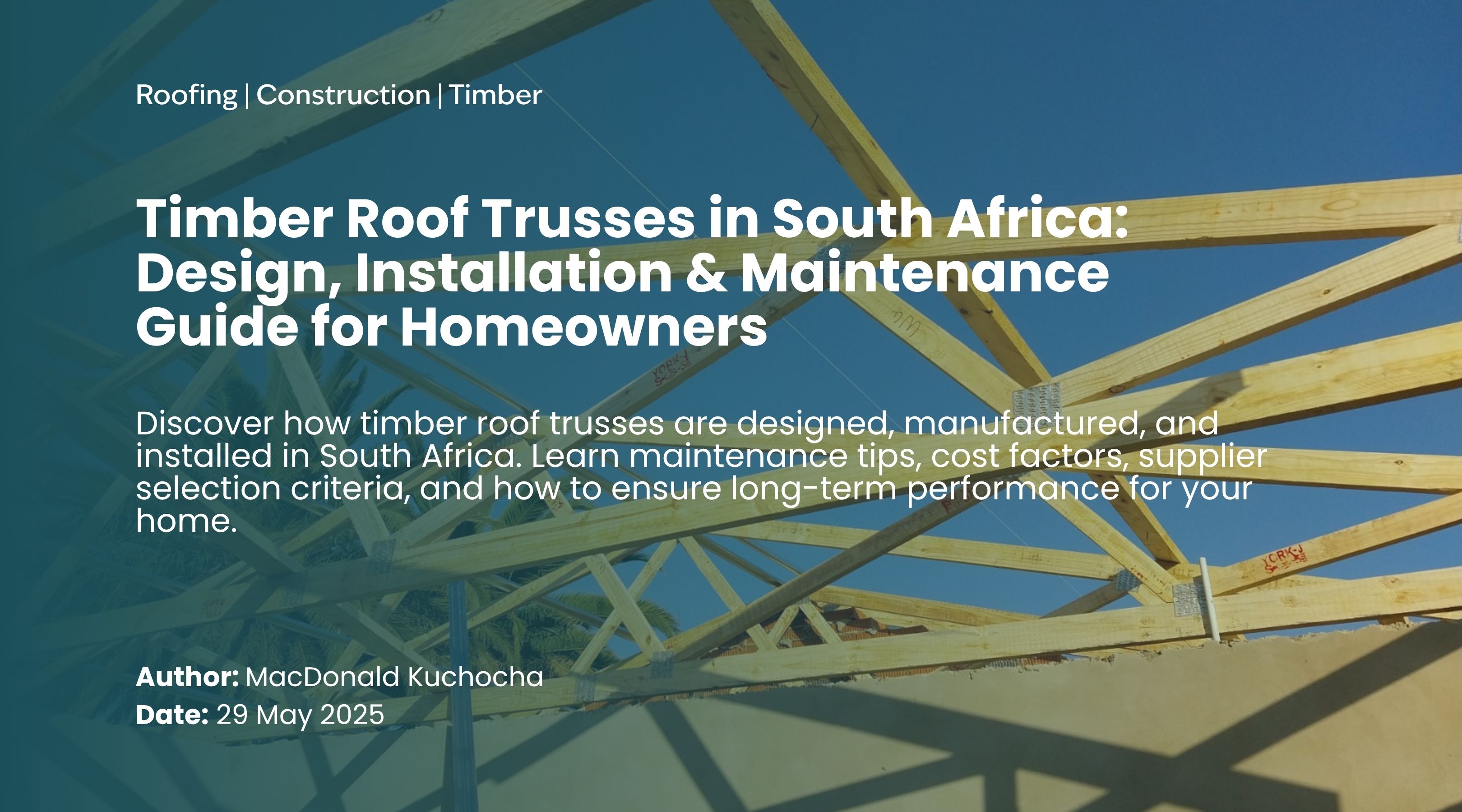If you’re considering timber roof trusses for your South African home, you likely already appreciate their aesthetic appeal and sustainability. (Haven’t explored these benefits yet? Read our companion article: [Why Timber Roof Trusses Are Ideal for South African Homes])
This guide focuses on the technical aspects—from design and manufacturing to installation, maintenance, and long-term value—to help you make an informed decision for your building project.
The Manufacturing Process
Design Phase
Modern timber truss design uses specialized software like MiTek’s Pamir to create precise structural frameworks that account for:
- Roof pitch and complexity
- Load requirements
- Span distances
- Connection details
This technology enables faster design iterations while ensuring compliance with South African building codes, resulting in trusses that perfectly match your home’s requirements.
Quality Production
Factory-manufactured timber trusses offer significant advantages over site-built alternatives:
- Joint gaps maintained at ≤1mm for optimal strength
- Consistent quality through controlled manufacturing conditions
- Precision cutting and assembly
- Rigorous quality control standards
Every piece of timber is kiln-dried, treated to appropriate hazard levels, and precision-cut before assembly with specialized nail plates and fixtures, ensuring dimensional stability and structural integrity.
Professional Installation Matters
Correct installation is crucial for timber truss performance. Expert installation teams ensure trusses are properly positioned, aligned, and secured. According to industry data, approximately 80% of roof structural failures stem from inadequate bracing or incorrect material choices.
A professional installation process includes:
- Verification of wall plate alignment and level
- Precise positioning of each truss
- Comprehensive bracing installation
- Quality control at critical stages
Maintaining Your Timber Trusses
With proper treatment and maintenance, timber roof trusses can last the lifetime of your home. South African pine trusses are treated to resist insects, fungi, and moisture, providing decades of reliable service.
Essential Maintenance Tips
- Regular inspections: Annual professional inspections can prevent 90% of structural failures, according to the Institute of Timber Construction South Africa.
- Manage moisture: Ensure good ventilation in roof spaces to prevent condensation buildup that could compromise truss integrity over time.
- Keep certifications current: Regular inspections by certified professionals maintain the validity of structural guarantees and Professional Indemnity Insurance—skipping inspections can void both product guarantees and insurance coverage.
Understanding the Investment
When evaluating timber roof trusses, consider both initial expenses and long-term value:
Cost Factors
- Roof complexity and size
- Timber grade and treatment specifications
- Design customization requirements
- Installation complexity
Long-Term Value
- Reduced energy costs through natural insulation
- Lower maintenance expenses compared to some alternatives
- Enhanced property value through aesthetic appeal and structural quality
- Extended lifespan with proper maintenance
At Roof Brands, our timber trusses comply with SANS 10400 building regulations and ITC-SA accreditation standards, ensuring you receive a quality product backed by professional guarantees.
Choosing the Right Supplier
Selecting the right timber truss supplier is crucial for ensuring quality, compliance, and long-term satisfaction. Look for:
Industry Credentials
Verify that your supplier holds proper accreditations, particularly ITC-SA (Institute for Timber Construction South Africa) membership and NHBRC (National Home Builders Registration Council) registration.
Design Expertise
Choose suppliers who use advanced design software and have demonstrated experience with projects similar to yours. Review their portfolio to ensure they can deliver the quality and style you expect.
Quality Materials
Ensure your supplier uses kiln-dried pine that’s FSC-certified and graded to SANS 1783-2 standards, guaranteeing sufficient load capacity and longevity.
Comprehensive Service
The best suppliers offer end-to-end solutions: design consultation, manufacturing, delivery, installation, and certification. This integrated approach ensures accountability throughout the process.
Key Questions to Ask Your Supplier
Before making your final decision, ask potential suppliers:
- Can you provide examples of similar projects you’ve completed?
- What guarantees do you offer on materials and workmanship?
- Are your designs and installations certified by qualified engineers?
- What is your quality control process during manufacturing and installation?
- What maintenance do you recommend, and do you offer inspection services?
Conclusion
Investing in timber roof trusses is an investment in your home’s long-term structural integrity, efficiency, and value. By understanding the manufacturing process, maintenance requirements, and selection criteria for suppliers, you can ensure your timber truss system delivers decades of reliable performance.
At Roof Brands, we’re committed to delivering superior timber truss solutions that meet the highest standards of quality and compliance. Our comprehensive approach ensures your roof not only looks beautiful but performs exceptionally for years to come.


